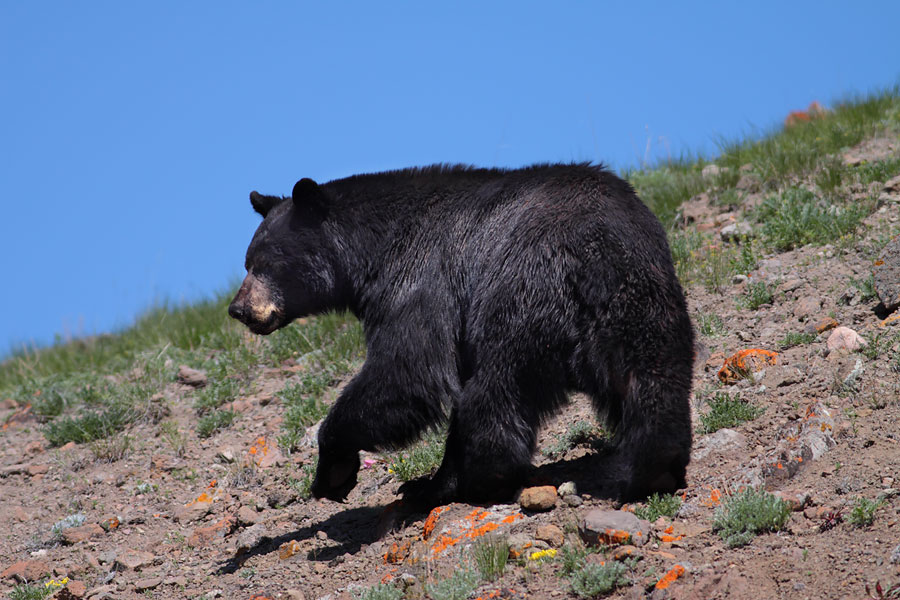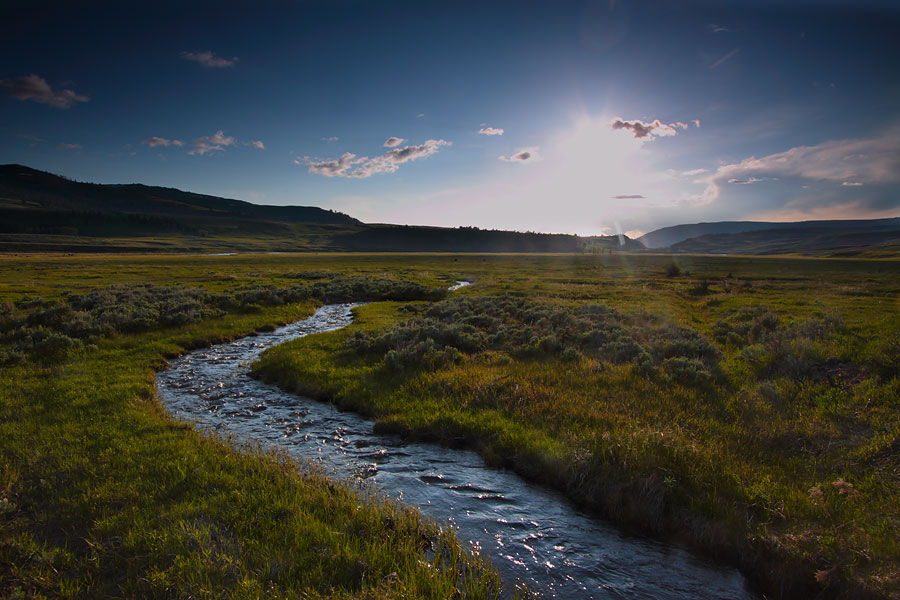|
|

Friday:
Birds are singing outside the cabin. Robins are building nests under the eaves of the shower buildings above the doors. There is a large round nest at the main lodge, above the railing on the porch, where a female goes back and forth feeding her babies. A sign has been carefully placed on the railing asking that no one sit under the nest, lest the mother abandon her young. Even walking at 9 p.m. birds are singing. On quiet evenings it is one of the sounds along with snorting bison and the soft nickering of horses I look forward to.

We stop briefly at Soda Butte to check on the Druids. A single wolf is on yesterday's carcass, but the sun is so intense, it's very difficult to see. The Druids have been crossing the road to go back and forth to the den so this means all is well with the Druid pups. We wait with others hoping to catch sight of the new additions to the pack and after a while move on to Slough Creek and Little America.
The Cottonwood Pack is on the basalt cliffs this morning across from Wrecker feeding on a carcass. Six adults, two black, including 716 F, and four gray. 716F was formerly known as the Dark Female in the Slough Creek Pack. Sort of on the fringe of that pack, she has found a home with 527F's pack. Apparently, one of the grays is new, or had not been noticed before, because Rick was remarking about it this morning. The alpha male is gray and uncollared while only 716F and 527F are collared. 527 is not there - she is back at the den with the puppies. I was really hoping to see her this time as alpha of her own pack with her own puppies. At seven years old, I've heard she is starting to gray.
The wolves walk back and forth from the carcass, climb on rocks and bed down in the grass. Their tiny faces are like little triangles peering at us as we watch through spotting scopes. Rick talks to an intern for quite a while and what I overhear is that 527 was the only wolf seen on the carcass yesterday. There is some speculation that 527 took the elk down herself! Some volunteers watched at Hellroarin where they eventually saw her return. I wish I had seen that. I don't even know where to look for the den from Hellroarin. The wolf watchers have been very tight lipped about anything and that has been frustrating.

On our way to Hellroarin Tim spots a deer with a fawn in a deep gully beside the road. It looks like the doe is lying down with the little white spotted fawn next to her. Hellroarin turnout is packed with vehicles and visitors, a park ranger waving cars and people along. There is a steep drop off where a year old black bear cub wanders over deadfall and through trees. He rolls on his back, legs in the air. He seems too small to be on his own, but the ranger tells us that his mother wants to breed again this year and has left him to be on his own.
We hike up the hill opposite Phantom Lake. This is a very steep, but short walk up the hillside into a meadow now filled with larkspur. Two black bears, a black and a cinnamon, are foraging on the hillsides in the distance. The black bear turns over rocks and zigzags down the hill, while the cinnamon follows a path in the opposite direction through trees and over logs. The black drifts toward the road and by the time we reach the road, a huge bear jam greets us. Long lines of cars in each direction crawl slowly while the bear surveys his options. He wants to cross, but the road is filled with vehicles and people, cameras in hand. Finally he charges across the road into a clearing, slipping behind trees and out of sight. We were just in time.
We turn around and walk down the road into Blacktail Deer Plateau, undriveable due to poor road conditions. It's the first time I remember hiking this road when there wasn't any snow on the road. The meadows are a sea of wildflowers: arrowhead balsamroot, larkspur, sticky geranium, harebells, mountain bluebells, forget-me-nots, shooting stars, oneflower heliantha, heartleaf arnica. I invested in a slender guide to Yellowstone wildflowers and we are trying to learn the names of wildflowers. It's not as easy as we hoped. We debate color, petal and leaf size and shape and are confused about some identities, but we still just enjoy their beauty, simple or intricate.

Earlier this morning we followed the Roosevelt fox into the meadows by the Ranger Station, and startled a mallard hen, sitting on her nest. She flew up into the air, trying to divert us and leaving her nest exposed. There are about eight cream colored eggs in her nest, hidden in the sagebrush. An egg, white and orange lay crushed near the car in the road. Someone else - maybe the fox - has found her nest. How ducks survive in this area is beyond us. Between coyotes and foxes there seems to be no safe place to nest and protect eggs and young.
This evening I walk the road to the river again. Grass and sage are muted green in the evening light. Usually bison, elk and antelope rest in the meadows between the lodge and the Yellowstone River, but tonight it seems like I am alone. I walk toward the river and the footbridge across the creek. The evening is warmer than yesterday; my heavy coat may be too much. I stand on the log footbridge and watch a dipper perched on a rock looking for insects. A white van slows on the other side of the road, pulling over to stop. The Roosevelt fox pops out of the tall grasses onto the road, trotting in a zigzag toward the river. He is a motley looking creature, shedding tan and brown and red tufts of fur. His tail is a fluffy plume flying high behind his slender body and legs as he hurries down the road, then up the slope that overlooks the river and disappears in the sage.
Author - Christine Baleshta
Photography - Tim Springer
 |
Click for larger image
|
|

